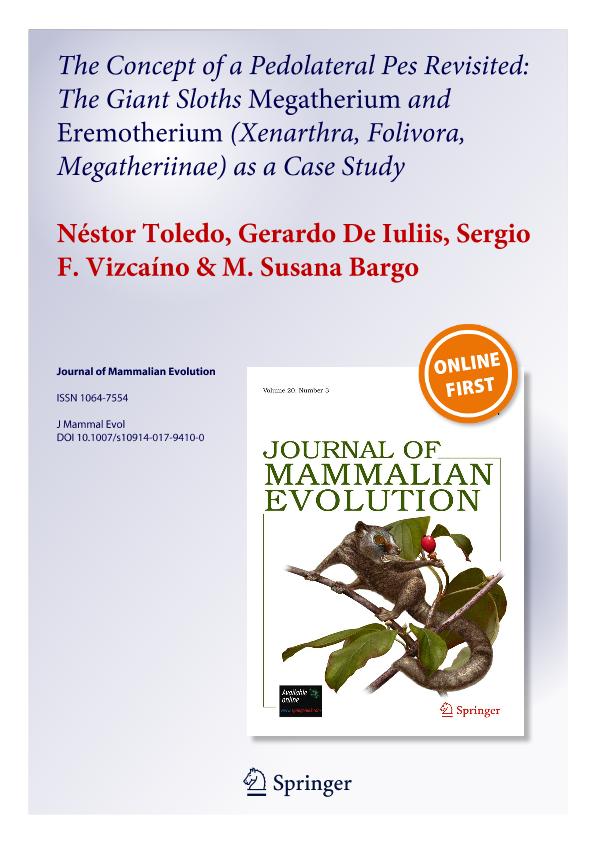Mostrar el registro sencillo del ítem
dc.contributor.author
Toledo, Néstor

dc.contributor.author
De Iuliis, Gerardo
dc.contributor.author
Vizcaíno, Sergio Fabián

dc.contributor.author
Bargo, María Susana

dc.date.available
2018-06-22T18:55:27Z
dc.date.issued
2017-09
dc.identifier.citation
Toledo, Néstor; De Iuliis, Gerardo; Vizcaíno, Sergio Fabián; Bargo, María Susana; The Concept of a Pedolateral Pes Revisited: The Giant Sloths Megatherium and Eremotherium (Xenarthra, Folivora, Megatheriinae) as a Case Study; Springer; Journal of Mammalian Evolution; 25; 4; 9-2017; 525-537
dc.identifier.issn
1064-7554
dc.identifier.uri
http://hdl.handle.net/11336/49702
dc.description.abstract
The concept of a pedolateral pes in many extinct sloths began effectively with Owen’s mid-nineteenth century descriptions of Glossotherium and Megatherium. Pedolaterality denotes a pes that is habitually inverted, with the digital plane oriented nearly vertically so that weight is borne largely by the lateral digits (mainly metatarsal V) and the plantar surface faces almost entirely medially. Subsequent researchers were strongly influenced by Owen’s interpretations. Astragalar morphology, with the medial and lateral portions of its trochlea forming, respectively, a peg-shaped odontoid process and a discoid facet, came to be viewed as a proxy for pedolaterality and, eventually, horizontal rotation around a nearly vertical axis as the main movement of the pes. Such motion necessitates a nearly vertical orientation for the odontoid process. However, analysis of the pes of the Pleistocene megatheriines Megatherium and Eremotherium, the astragalus of which conforms to the type usually interpreted in the literature as indicative of pedolaterality, suggests that the pes was not strongly inverted. Rather, the digital plane was about 35o to the horizontal plane, so that weight was borne largely by metatarsal V, but also by metatarsal IV and possibly the ungual phalanx of digit III. The astragalus was positioned so that the odontoid process was oriented obliquely to the vertical axis. With this element so positioned, mediolateral rotation in the horizontal plane was minor, and the main movement of the pes produced dorsiflexion and plantar flexion in nearly the parasagittal plane, the usual movement of the pes in terrestrial mammals.
dc.format
application/pdf
dc.language.iso
eng
dc.publisher
Springer

dc.rights
info:eu-repo/semantics/openAccess
dc.rights.uri
https://creativecommons.org/licenses/by-nc-sa/2.5/ar/
dc.subject
EXTINCT SLOTH
dc.subject
FOLIVORA
dc.subject
FOOT ANATOMY
dc.subject
FOOT INVERSION
dc.subject
XENARTHRA
dc.subject.classification
Paleontología

dc.subject.classification
Ciencias de la Tierra y relacionadas con el Medio Ambiente

dc.subject.classification
CIENCIAS NATURALES Y EXACTAS

dc.title
The Concept of a Pedolateral Pes Revisited: The Giant Sloths Megatherium and Eremotherium (Xenarthra, Folivora, Megatheriinae) as a Case Study
dc.type
info:eu-repo/semantics/article
dc.type
info:ar-repo/semantics/artículo
dc.type
info:eu-repo/semantics/publishedVersion
dc.date.updated
2018-06-22T15:03:14Z
dc.identifier.eissn
1573-7055
dc.journal.volume
25
dc.journal.number
4
dc.journal.pagination
525-537
dc.journal.pais
Alemania

dc.description.fil
Fil: Toledo, Néstor. Universidad Nacional de La Plata. Facultad de Ciencias Naturales y Museo. División Paleontología Vertebrados; Argentina. Consejo Nacional de Investigaciones Científicas y Técnicas. Centro Científico Tecnológico Conicet - La Plata; Argentina
dc.description.fil
Fil: De Iuliis, Gerardo. University of Toronto; Canadá. Royal Ontario Museum; Canadá
dc.description.fil
Fil: Vizcaíno, Sergio Fabián. Universidad Nacional de La Plata. Facultad de Ciencias Naturales y Museo. División Paleontología Vertebrados; Argentina. Consejo Nacional de Investigaciones Científicas y Técnicas. Centro Científico Tecnológico Conicet - La Plata; Argentina
dc.description.fil
Fil: Bargo, María Susana. Universidad Nacional de La Plata. Facultad de Ciencias Naturales y Museo. División Paleontología Vertebrados; Argentina. Provincia de Buenos Aires. Gobernación. Comisión de Investigaciones Científicas; Argentina
dc.journal.title
Journal of Mammalian Evolution

dc.relation.alternativeid
info:eu-repo/semantics/altIdentifier/doi/http://dx.doi.org/10.1007/s10914-017-9410-0
dc.relation.alternativeid
info:eu-repo/semantics/altIdentifier/url/https://link.springer.com/article/10.1007%2Fs10914-017-9410-0
Archivos asociados
